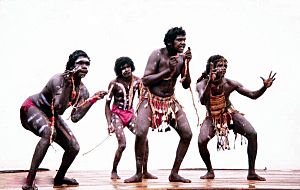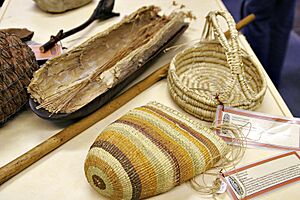Australian Aboriginal fibrecraft facts for kids
Australian Aboriginal fibrecraft is about how Aboriginal Australians traditionally make things using natural fibres. The materials they use depend on where they live in Australia.
Contents
Using Bark for Crafts
Many Aboriginal people across Australia use bark. Even today, this skill helps create beautiful baskets. These baskets are very popular with tourists.
Some popular barks come from the kurrajong tree and river wattles. Other trees like Sandpaper figs, banyans, and peanut trees are also used.
In northern Australia, people make tightly woven items. In the south, they often create looser string bags. These are commonly known as dilly bags.
Hairstring: A Special Fibre
Hairstring is a very important textile traditionally made by Aboriginal Australians.
People, especially women, would regularly cut their hair. They used quartz or flint knives for this. This hair was never wasted. It was spun into long threads of yarn. This was done on a spindle, often rolled on the thigh. Then, it was plaited to be as thick as 8-ply wool.
Hairstring had many uses. It was used to make head rings for carrying coolamons. It also made headbands to keep hair out of the face. It helped make spears by securing the head to the shaft. It was even used to make balls for games.

A general-purpose belt was made from the string. People could hang things from it. This included small animals like goannas. This helped keep their hands free during long walks and hunts.
For some groups, like the Pitjantjajara people, young girls wore a small modesty apron made of string. This was worn when they reached puberty.
Some tribes had adults wear a loincloth-like covering. This also hung from the waist belt. It could be made of string or other materials like paperbark. In the Kimberley region of Western Australia, men wore special pearl shells. These were called Riji and were very sacred.
The string could be dyed different colours. Dyes like ochre were used. Some string was only worn for ceremony, such as skirts worn by women.
Fun with String Games
Many Aboriginal groups traditionally made many shapes using string. This is like the game "cat's cradle."
One researcher watched a young Aboriginal woman from Yirrkala. She made over 200 different string figures. Each one needed complex movements of her fingers and thumbs. She remembered the correct steps for almost every figure. If she made a mistake, she quickly fixed it. As she made each figure, she gave it a name. Some names included dangurang (a lobster) and gapu (ripples on a pool).
The Bangarra Dance Theatre used traditional desert string games in a show in 2005. The dancers created amazing patterns by threading themselves through long, elastic strings.
Crafting with Grasses

Grasses are sometimes mixed with hair to make a stronger fibre. The types of materials used depend on the area in Australia. In dry areas, spinifex is common. In the Top End, palms like pandanus are often used.
Pandanus and sand-palm are used in places like the Daly River region and Arnhem Land. They are woven into carry baskets, dilly string bags, and wall hangings. They also make fibre sculptures, floor mats, and fish nets. The women of Peppimenarti and Gunbalanya are famous for their weaving. Each community has its own unique styles and techniques.
See also



